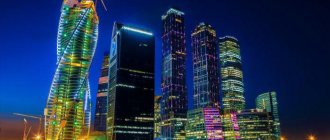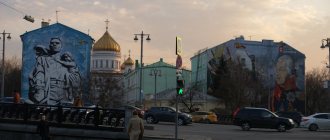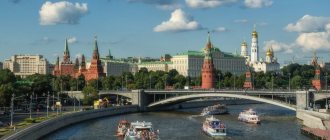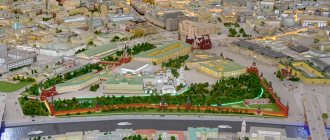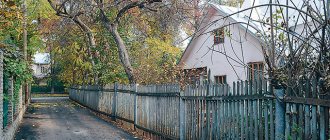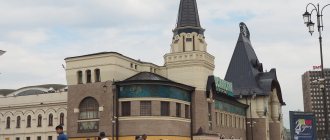Opinion of historians
Experts say that the capital of Russia is so called because in ancient times there was a stone fortress in its place. Moscow consists of two Old Russian words - “mosk” (stone) and “kov” (hide). Thus, the name of the city means a stone fence behind which civilians hid during the raids of nomadic tribes. Afterwards, the river flowing next to the fortress began to be called this way.
In addition to the main version put forward by historians after careful study of chronicles and scrolls that have been preserved for many thousands of years, there are several more brief explanations for why Moscow was called Moscow. All theories have the right to exist, as they are documented.
Imprint of foreign predecessors
Linguists are still arguing about its origin, attributing the slightest similarities in sound to different peoples living in these places in ancient times. They are unanimous on one thing: the river was the first to acquire this name, and the area in its vicinity inherited it later. This is confirmed by many examples of historical chronicles.
Some ethnographers and linguists are confident that the dialects of the Finno-Ugric tribes gave the name “Moscow” to the current capital. In translation, “mosk” meant “cow” or “bear” (among the Meryans), and “va” meant “water.” It turns out that in the valleys of the beautiful river with an abundance of lush grasses, herds of livestock grazed and large wild animals lived.
Some daredevils have found similar roots even among the Komi peoples. Their toponym “Cow Water” (“mosk” and “va”) also indicates the conduct of mass farming in the vicinity of the ancient city. But for some reason the impressive distance does not bother adherents of this theory.
However, there are completely different versions. According to one of them, in the language of the Erzya tribes (Mordovian ethnic groups), the name of the ancestral capital consisted of two parts. The first “mazy” means red, the second “kuva” means district, region. The ancestors of the Mordovians called the city a “Beautiful Place”.
Interesting: Why is Latin America called Latin? Description, photo and video
Other scientists rely on connections with ancient Turkic dialects. Nomads (Kipchaks) raided Slavic settlements, capturing mostly men to then sell into slavery in the east. The conquered were called "maskeu". The root “mas” meant son-in-law, man, the second part of the word was translated as “drunk.” It seems that the fame of the passions of their ancestors was known to others long before they received permanent nationality.
Slav theory
According to the ancient Slavs, “Moscow” is a derivative of the word “mosk”. In their language, it denoted a sticky, swampy and marshy area. Mosk also called moisture, that is, a river flowing through the Russian capital.
This version is confirmed by the presence of a river with a similar name in Transcarpathia (Ukraine). In Germany and Poland there is the Mozgawa River, and in Belarus - the Maska.
The Slavs used the word “Mosk” to refer to the entire territory of Russia, which is now occupied by the capital. But it was unusual for the ears of the inhabitants of Rus', so the city was called Moscow.
According to the chronicle, in the XIV-XV centuries. Moscow was named Kuchkov. The capital returned its original name after the death of Boyar Stepan Kuchkov, who was killed by Prince Yuri Dolgoruky.
Moscow and pre-Slavic roots
Many linguists are inclined to the original Slavic origins of the origin of their own name. According to one hypothesis, the root “mosk” meant “stone”, and the ending “kov” meant shelter. The word put together transformed into “fortress.” It turns out that the settlement itself was named first, behind whose walls the residents felt safe. And later the river received the same nickname.
Another theory suggests that “mosk” (or “brain”) corresponds to the meaning of swamp, marshy area, moisture. In fact, Belokamennaya was built precisely on swamps. This etymology is supported by consonant and even identical names of rivers in other languages of related peoples. The Mozgawa flows through Poland, in Belarus there is the Maska, and in Ukraine there is the Moskva River.
“Moskva” was the name for a winding river.
“Moskva” was also a name for a winding river. Looking from above at the bends of the Moskva River along the Moscow Ring Road, it is easy to notice multiple sharp turns of the water ribbon. It is not difficult to imagine the adjacent floodplain meadows and low banks as flooded.
In the 19th century, a group of linguists favored the unlikely claim that the name Moscow was derived from the ancient word “mostki” (small bridges across a river). Other minds convinced their compatriots of the involvement of midges in the toponym, which abound in the marshy areas.
Interesting: Why do the words “mother”, “brother” and the like sound similar in many languages?
Opinion of residents of the Baltic Sea countries
Russian philologist and linguist Vladimir Toporov has been studying the culture of the Baltic people for a long time. The scientist argued that the territory of Moscow is located in the region of Baltic hydronymy. The name of the Moscow River has the root mask (mazg), which is translated from the Baltic dialect as swamp and mud.
Based on this, it can be argued that the name of Moscow means a muddy and winding river. But among experts, Toporov’s version caused heated debate. On the one hand, he is right, but the Moscow River winds only in the area of the Moscow Ring Road. They doubt that the huge city was named only because of a small area of a reservoir.
The capital after the 1917 revolution
After the revolution of 1917, the capital of the new power remained St. Petersburg, which before that, from 1712, was the residence of the rulers of the Russian Empire, and after the Bolsheviks came to power, their headquarters. But, during the First World War, after unsuccessful negotiations with Germany and the threat of an attack on the capital, as well as for a number of political reasons and the possibility of a revolt against the Bolshevik government, the government began evacuating the upper strata of the population to Moscow. In March 1918, Vladimir Ilyich Lenin secretly went to Moscow and in the same month, after all the key political figures moved, Moscow became the official capital of the Soviet Union.
Related article: Why do people drink water?
Finno-Ugric theory
Finno-Ugric peoples inhabited the territory of modern Moscow for a long time. Their language has the same word as in Slavic - “mosk”. But among the Finns and Ugrians it means not “river”, but “cow”.
According to the theory of some historians, the Finno-Ugric peoples named the area Moscow because the meadows and fields around the river were a good place for grazing livestock. This word translates as "cow river".
Why Moscow became the capital
Moscow became the capital of the Russian land several times and for good reason. This was facilitated by a number of reasons that make the location more advantageous from a political and geographical point of view in relation to other cities:
- Moscow's location between eastern and western Russia, in the very center of the country, made it a stronghold of development. It was here that crafts originated and developed and trade flourished.
- The convenient location at the intersection of rivers and trade routes made the city's position favorable from an economic point of view.
- Natural resources around the city allowed the development of crafts and trade with other cities.
- The strategic location of the city made it possible to repel enemy attacks, as well as quickly restore strength and resources after battles.
- Moscow was one of the cities that, due to its location, were less likely than others to be attacked by enemy principalities; it was here that people fleeing the war sought refuge.
- Moscow is the geographical center, which made it possible to unite the neighboring principalities around itself.
Similar article - Why you can’t give a watch?
The name comes from legends
According to legends that appeared in the 17th century, the name of the Moscow River and the city on it is associated with the descendant of Noah - Mosokh. His children, grandchildren and great-grandchildren settled the lands that are located between the Vistula and the White Sea, and became the ancestors of the Russian people.
Therefore, the large city of Moscow was named after Mosoh. Over time, this legend was supplemented with fiction. For example, they say that Mosoh was the husband of a girl named Kwa. This is where the word “Mos+kva” came from.
However, historians do not confirm this. This assumption has no basis and is not mentioned in any of the documents left by the ancestors.
Until now, scientists have not come to a consensus on where the word Moscow came from. They are not going to believe legends and myths, and the version of linguists is far-fetched. The only plausible theory of the origin of the name of the Russian capital remains that Moscow is translated as “stone fortress.” At least this is often mentioned in ancient chronicles, unlike other versions.
From Belokamennaya to Nerezinovaya: 10 main nicknames of Moscow
Where did the popular names of the capital come from?
K.F. Yuon, “Moskvoretsky Bridge. Old Moscow", 1911
People call our capital in every possible way: from the derogatory Nerezinovaya to the pompous Third Rome, or even the Port of Five Seas - although not a single sea can be found in Moscow during the day. We decided to figure out what all these nicknames of our beloved city mean and how they came to be.
Moscow - Third Rome
“The first two Romes perished, the third stands, but the fourth will not exist” - these words, spoken at the beginning of the 16th century by the Pskov monk Philotheus, gave Moscow one of its most famous nicknames, which at one time determined the ideology of the entire country.
In 1453, after more than a thousand years of existence, the Byzantine Empire fell under the onslaught of the Ottoman Turks. At the same time, a new state began to gain power in the north—the Principality of Moscow, whose leadership became concerned with the search for a national idea.
There was no need to think long - the idea of succession to Byzantium among the learned people already had its followers, one of whom was the Pskov monk Philotheus. In his message to Tsar Vasily, he was one of the first to formulate this concept, placing Moscow on the same historical level as Rome and Constantinople.
Moscow white stone
Finding a building made of white stone in Moscow today is not so easy. However, this famous nickname for the capital did not come out of nowhere. For a significant part of its centuries-old history, the main symbol of Moscow - the Kremlin - was white as snow.
The first two centuries of its existence, the walls of the Kremlin were wooden, or rather oak. But after two fires that occurred with an interval of 20 years and completely destroyed them, Tsar Dmitry Ivanovich Donskoy finally decided to rebuild the walls from white limestone stone, which was imported directly from the region. Since then, Moscow has been given the nickname “white stone”.
Painting by Vereshchagin “View of the Moscow Kremlin”, 1879
The Donskoy Kremlin stood until the middle of the 15th century, until it completely fell into disrepair, after which Tsar Ivan III decided to rebuild it. Thanks to the invited Italian architects, the Kremlin we know today - brick and red - appeared.
About a hundred years after this, a new white wall appeared in Moscow, but this time it surrounded the so-called White City, a historical territory in the center of Moscow. Under Catherine II, the Boulevard Ring arose in place of this wall.
But Moscow was not destined to stand for long without white walls - at the end of the 18th century, the red Kremlin wall was whitewashed in accordance with fashion trends. The Kremlin stood in this form until 1947.
As you know, after the revolution the Bolsheviks made the Kremlin their residence and closed the historical fortress from visitors. After the Great Patriotic War, Stalin decided to return the color red to the Kremlin, as it was more consistent with the official ideology. By the way, after the collapse of the USSR, the idea of painting the Kremlin back white was expressed more than once by famous people and government officials.
Moscow the Mother Throne
Peter I's transfer of the capital to St. Petersburg deprived Moscow of the title of the most significant city in the newborn empire, but it was impossible to completely offend the historical homeland of the Russian state. Therefore, Moscow was officially named the “first throne”, that is, the city in which the very first Russian royal throne was located.
It turned out that St. Petersburg is the capital, but historically Moscow is still more important. Today the city can rightfully be called the third throne - after the fall of first the tsarist and then the Soviet power and the transfer of the capital back in 1918.
Moscow golden-domed
Golden domes are one of the main symbols of old Moscow. It reflects the historical religiosity of the Russian capital.
Fedoskino miniature “Golden-domed Moscow”, S. Chistov
Before the revolution, the expression “forty forty” was in use, denoting the number of churches in Moscow (that is, 40 times 40 churches). And although in reality there were not 1600, but about a thousand, this number still made Moscow one of the first cities in the world in terms of the number of churches.
For comparison, in 1990 there were only 155 Orthodox churches left in Moscow, and in 2011 there were already about 600, although services were not held in all of them.
Moscow - a city on seven hills
Another nickname for Moscow, emphasizing its connection with Rome, because it is the “eternal city” that is believed to have grown on seven hills. The legend of similar seven Moscow hills has been known since approximately the 16th century - right from the very time when the concept of “Moscow is the third Rome” came into use.
It is curious that at different historical times different seven hills were identified in Moscow. If in the middle of the 16th century these were Borovitsky, Tagansky, Krasny, Staro-Vagankovsky and Chertolsky hills, as well as Ivanovo and Pskov hills, today Tverskoy, Sretensky, Lefortovo or Sukharevsky hills, Shvivaya and Strastnaya hills, Vvedensky hills can be arbitrarily added to this list and even Vorobyovy Gory, built only in the 1950s.
Among the major cities of the world, Moscow and Rome are far from the only ones located on seven hills. The same nickname is also used in relation to Istanbul (formerly Constantinople), San Francisco, Washington, Kyiv, Chisinau, Nizhny Novgorod and many others.
Moscow is a big village
This may seem surprising, but the expression about a large village appeared relatively long ago - around the middle of the 19th century. It is precisely this comparison of Moscow that can be found, for example, in the correspondence of the literary critic Belinsky.
There is a whole legend about the origin of this nickname - supposedly the corresponding expression was first uttered by Empress Catherine II, and by mistake. According to legend, she wanted to say the phrase: “And Moscow was a village,” which means: “And Moscow was a village,” but someone around her heard the word “big.”
Photo: pastvu.com/p/3392
Market near the Bolshoi Ustinsky Bridge (now the center of Moscow), 1902
Moscow patriots will notice that the mistake was already contained in the empress’s original phrase - Moscow has never been a village in its history. At least that's what the chronicles tell us.
Today, the “big village” is most often mentioned in the context of unexpected meetings in the middle of the city, like: “I’m driving in a traffic jam, and in the next car is the guy with whom I went to kindergarten in Uryupinsk!” This brings us to the next relevant example.
Moscow non-rubber
We can talk endlessly about the overpopulation of Moscow - eternal traffic jams, crushes in the subway, overcrowded public transport, constant smog due to cars, the phrase “We're here in large numbers!” uttered by a native of the so-called Uryupinsk and, as a result, an increased level of aggression among city residents.
Russia is an overly centralized country and everyone suffers from this, including Moscow. Of course, attracting people from all over the world is a common fate for big cities. But in Moscow, the situation is aggravated by the city’s not very successful logistics, in particular, by the insufficient number of roads.
On the other hand, there are many cities in the world where the situation is even worse - for example, the average Muscovite would hardly want to move to Mexico City, Delhi or Beijing. As the experience of other countries shows, the constant influx of people to the capital will stop only with an improvement in the standard of living in the provinces, which cannot be expected in the near future due to the economic situation in the country.
Moscow - a port of five seas
It would seem, what kind of seas can we even talk about when Moscow is located in the very center of the East European Plain, and the nearest sea coast is located in St. Petersburg?
However, such a nickname has its own meaning. It appeared after the construction of two grandiose canals - named after. Moscow and Volga-Don. It was then that it became possible to sail from Moscow by water to five seas at once - the Baltic, Black, Azov, Caspian and White.
Photo: pastvu.com/p/37512
Ships at the pier of the Northern River Station of Moscow, 1937
Of course, any other city connected by water to the Moscow River can be called a port of five seas in a similar way. In general, the project to connect the capital with the five seas by water arteries has hardly lived up to its grandiose plan - today only an insignificant part of the cargo is delivered to Moscow by water.
Default City
If folk culture is blooming anywhere these days, it is definitely on the Internet. Default City (abbreviated as “DS”) is how Moscow is usually called on various forums, image boards, in Internet culture encyclopedias and social networks.
The phrase default city is translated as “default city” - it is found in various questionnaires and forms to fill out when you need to indicate your place of residence. For example, if you buy something in an online store, then the default city in the column is usually Moscow. Next, as a rule, comes St. Petersburg, which rightly staked its claim to the nickname DS-2.
But several cities are vying for the title of DS-3 in Russia - Novosibirsk, Yekaterinburg, and even Kazan. It is curious that historically the third capital of Russia is usually called not these cities at all, but Omsk or Samara, which served as capitals for the anti-Bolshevik government during the Civil War.
Moscow is the merchant/financial/business capital of Russia
Although the capital of Russia was in St. Petersburg for a long time (and not the worst in history), the center of its business life was always located in Moscow. Moscow was called merchant Moscow under the Tsar, “thieves’ Moscow” in the USSR, when people went to the capital en masse to get new boots or buy sausage, and the financial and business capital was already in the Russian Federation.
Photo: Oscar W. Rasson / Flickr.com
View of the Moscow City business center
In the 2000s, construction of the Moscow City skyscrapers began in Moscow, which were to become the center of the country's business life. Under Medvedev, there was a whole concept of turning Moscow into one of the financial capitals of the world.
Although today these plans look somewhat naive, the situation inside Russia as a whole has not changed - the lion's share of all the largest companies in Russia is still registered in Moscow, and it is here that most of the national wealth flows, in order to then be distributed back to the regions (and partially - settle in your pockets).
It is for this reason that outside the Moscow Ring Road the golden-domed and white-stone third Rome is rather disliked by the people today.
Maxim Kalinnikov
What other cities became the capital of Russia?
Of course, St. Petersburg, it became the main city twice - in 1712 and in 1730. But in 1918, a new era began - the Soviet era, the title of the main city again returned to Moscow.
However, we are talking about megacities, but few people know that much smaller settlements bore this proud title:
- From 882 to 1243 Kyiv was the capital;
- Further, until 1432, the center of fragmented Rus' was Vladimir-on-Klyazma;
- From 1564 to 1581, the Alexandrovskaya Sloboda was awarded this honor;
- And in 1612 - for several months in Yaroslavl, during the Czech occupation.
Among other things, there were renaming projects; the authorities wanted to give the metropolis a more sonorous name. The options were:
- Ilyich;
- Stalinodar;
- Stalin.
But none of the names stuck because the regimes changed too quickly.

